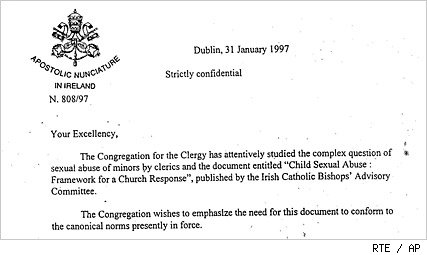By David Gibson
Politics Daily
January 19, 2011
http://www.politicsdaily.com/2011/01/19/vatican-letter-to-irish-bishops-on-sex-abuse-a-smoking-gun-in/
The Vatican is scrambling to tamp down yet another crisis in the ongoing clergy sexual abuse scandal, this time over the revelation of a 1997 letter from a senior Vatican official telling the bishops of Ireland not to implement their new policy of reporting abusive priests to law enforcement authorities.
Advocates for victims and other critics say the letter from the Vatican's envoy to Ireland at the time is a "smoking gun" proving their claims that the Vatican helped direct an effort to conceal abuses for years.
"The letter is of huge international significance, because it shows that the Vatican's intention is to prevent reporting of abuse to criminal authorities. And if that instruction applied here, it applied everywhere," said Colm O'Gorman, director of the Irish chapter of the human rights watchdog Amnesty International.
 |
The January 1997 letter is from papal nuncio Archbishop Luciano Storero to the Irish hierarchy. It states that the Vatican's Congregation for Clergy, which oversees policies for the more than 400,000 priests around the world, said the bishops' new policy of mandatory reporting of suspected sex crimes by priests to police "gives rise to serious reservations of both a moral and canonical nature."
Storero (who died in 2000) wrote that canon law, which governs abuses and legal matters within the church, "must be meticulously followed" and any bishop who took actions that did not follow canon law would face the "highly embarrassing" position of being overturned on appeal in Rome. Such a result would be "detrimental" to the bishop in question, the Vatican warned.
The letter closes with a stern admonition to the bishops that Vatican policies must be "meticulously" adhered to.
The newly revealed letter was obtained by Irish broadcasters RTE and provided to The Associated Press.
The bishops of Ireland had adopted their new policy in 1996 as the first wave of clergy abuse scandals was being made public and the letter represented the Vatican's first official reaction.
Vatican officials on Wednesday sought to downplay the letter's importance and to shield Pope Benedict XVI -- formerly Cardinal Joseph Ratzinger, a top Vatican official during the era of scandals -- by noting that the Vatican had begun dealing more forthrightly with abuse cases in 2001 when the late John Paul II gave Ratzinger responsibility for coordinating Rome's efforts on clergy abuse cases.
In addition, Jeffrey S. Lena, a U.S.-based lawyer for the Vatican, said the letter from Storero had been "deeply misunderstood."
"In stark contrast to news reports, the letter nowhere instructed Irish bishops to disregard civil law reporting requirements," Lena said in a statement.
Ireland had no reporting requirements for the sexual abuse of children at the time, and the policies adopted by the Irish bishops were actually ahead of civil laws in that regard. The Vatican is still developing a comprehensive policy for the world's bishops to deal with clergy abuse cases, and it was only last April, amid a firestorm of criticism over its handling of cases, that the Vatican published a set of informal guidelines that said civil law "concerning reporting of crimes to the appropriate authorities should always be followed."
A Vatican spokesman, the Rev. Federico Lombardi, on Wednesday took a somewhat different tack from Lena, saying that the letter's "ideas about collaborating with civil authorities" have been "surpassed."
"It refers to a situation that we've now moved beyond," Lombardi said.
Lombardi also said that people in Ireland had been aware of the existence of the letter. "It's not new," he said, according to The New York Times. "They've known about it in Ireland for some time."
In fact, sources had spoken to Irish media about the letter but its exact contents had never been published. And in many respects the 1997 letter reflects what was already known about the Vatican's endemic culture of secrecy. The head of the Vatican's Congregation for Clergy at the time, Cardinal Dario Castrillon Hoyos, was a sharp critic of media efforts to cover the scandal, and last April it emerged that Castrillon had praised a French bishop who risked jail rather than report child abuse by one of his priests to police.
But the publication of the letter to the Irish bishops was understandably galling to victims advocates and others, as it seemed to put the conspiratorial church culture in black and white.
"Time and time again, Vatican officials have denied telling bishops to conceal child sex crimes," said Barbara Dorris, outreach director of SNAP, the Survivors Network of those Abused by Priests, the leading U.S.-based victims organization. "Now, however, it's clear that they did, at least in Ireland (and we suspect elsewhere as well)."
The letter's emergence is also problematic given that the Vatican recently announced that Benedict will beatify John Paul on May 1, a highly anticipated event that will put the late pontiff one step from sainthood, but just as some of the uglier aspects of his administration are emerging.
The 1997 letter may not burnish Benedict's reputation either.
As new abuse revelations swept across Europe last year they hit Ireland particularly hard. The pope finally responded with a letter to Irish Catholics that expressed his sorrow at the abuse but also blamed the abuse on "fast-paced social change" and a lack of religious devotion by ordinary Irish Catholics, who until recent years have been the most devout Catholics in the world.
Benedict's letter also chided the bishops for the "often inadequate response" of Ireland's hierarchy to the abuse and pointed to "a tendency in [Irish] society to favor the clergy and other authority figures."
Apparently, that tendency may have been more of a problem in Rome than in Dublin.
Any original material on these pages is copyright © BishopAccountability.org 2004. Reproduce freely with attribution.